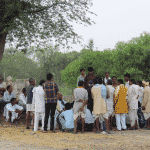What is the issue?
- The Cauvery basin covers large parts of Karnataka, Tamil Nadu and some parts of Puducherry and Kerala as well.
- Karnataka and Tamil Nadu have been fighting over the issue since 1892.
- There was an agreement signed in those times to use the water of the river evenly, but it did not work out.
- A fresh treaty over the water was then signed between the two states in 1924 under the supervision of the Government of India.
- But in 1970, both Puducherry and Kerala jumped in the fray and demanded their share of the river water.
- So a fact finding committee was setup to figure out the situation on ground which submitted it’s report in 1972 and the states reached an agreement in 1976.
- But by this time there was a new Government in Tamil Nadu which refused to accept the terms of the agreement.
- The problems persisted and thus in 1986, Tamil Nadu requested the Government of India to set up a Cauvery Water Tribunal for solving the issue under the Inter-State Water Disputes Act, 1956. The Tribunal came into being in the year 1990.
- After 17 years of hearing and deciding, the Tribunal in 2007 gave its award which allocated 419 tmc ft water to Tamil Nadu, 270 tmc ft to Karnataka, 30 tmc ft to Kerala and 7 tmc ft to Puducherry.
- The Tribunal concluded that total availability of water in the Cauvery basin stood at 740 tmc ft.
- The remaining 14 tmc ft was accounted as reserved for envronmental protection and outflow to the sea.
- But, both Karnataka and Tamil Nadu filed a review petition before the Tribunal.
- The problems continued and finally in 2012, Prime Minister Manmohan Singh, as the Chairman of Cauvery River Authority asked Karnataka to release 9,000 cusecs of water daily. But Karnataka did not pay heed.
- The Supreme Court criticized the Karnataka government. As a result, the State government offered an unconditional apology and started the release of water which led to widespread protests.
- Later, Karnataka stopped the release of water again. This made the Tamil Nadu government to decide to sue Karnataka for contempt of court.
- Chief of Tamil Nadu filed an interlocutory petition in the Supreme Court in August, 2016 seeking the release of water as per the directives of the Cauvery Tribunal.
- In its verdict, the Supreme Court has now directed the Karnataka government to release 12,000 cusecs of water to its neighboring states for 10 days.
What led to the current mayhem?
- The Cauvery issue blew up because of the increase in demand for its water which was mainly due to three reasons.
- The expansion of cities such as Bengaluru and Mysuru.
- The drying up of other water sources like ground water, due to excessive exploitation and contamination.
- The growth of water intensive but not necessarily water-efficient crops over the years.
- The decreased flow and diminishing catchment area of the river made the increasing demands for water unsustainable.
- The dispute escalates when monsoon fails, as there is lesser water to share. and this year, Karnataka and Tamil Nadu have received less than normal rainfall during the monsoon. Karnataka says it cannot release water to Tamil Nadu as it needs it for drinking water purposes.
- The pro-Kannada activists say that the state has just enough water in its Cauvery reservoirs for its own drinking and irrigation needs.
Way Ahead
- Tribunals have been criticized for the delay in their constitution and the delay after they have been constituted. To determine the economic value and optimal distribution of a river’s water, water tribunals have to become more efficient and effective.
- As has been outlined by the United Nations Convention on the Law of the Non-Navigational Uses of International Watercourses, equitable and reasonable use of water, application of appropriate measures to prevent harm to other states on the river course, and the principle of prior notification of planned measures should be an integral part of any river water sharing agreement.
- The cultivation of water intensive crops should be avoided, especially in rainfall deficit areas.
- There should be a rational pricing mechanism, as is the case for any demand-supply gap situation. Resource overuse and wastage are a direct consequence of it being under priced or not priced at all. Pricing water according to its availability in the monsoon and drought years would stop the problem associated with overuse.
- Farmers in Karnataka and Tamil Nadu need to understand each other’s needs and fears and collectively seek solutions. Non-political initiatives, such as the ‘Cauvery Family’, a body formed a few years ago covering farmers of both states, could help disperse the violence erupting whenever the Cauvery crisis comes to the fore. Politics and passion should not be allowed to hold sway.
- Any distress sharing formula should come from a technical body. It would have helped if the Centre had set up the Cauvery Management Board and Regulatory Authority. A major problem in implementing the award of the Tribunal was the absence of a ‘Cauvery Management Board’ and a Regulatory Authority.
- Rather than lean on the Judiciary for solutions, the fours states need to shed their present regional approach and plan collectively for the whole river basin.
- Overdependence on the Cauvery should be reduced by encouraging decentralised water management.











